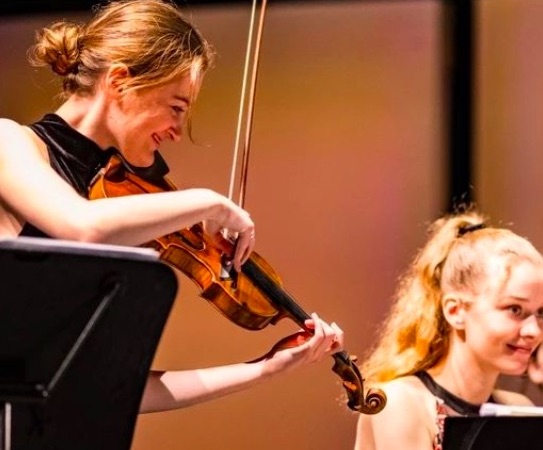The City Recital Hall in Sydney’s Angel Place is usually quiet on a Saturday afternoon, drawing only the most passionate classical music lovers together for restrained matinees of Beethoven, Bach and Brahms. But the audience at Wildschut & Brauss’ opening performance filled the auditorium with a refreshing energy. Young children giggled in their seats. Friends whispered together between sips of champagne. Strangers turned to each other, chatting eagerly about the upcoming programme.
This energy was matched by the youthful vivacity of Noa Wildschut and Elisabeth Brauss. Still in their twenties, the pair have performed together since 2018, receiving critical acclaim both as a duet and in their individual performances.
Wildschut is something of a violin prodigy. Born in the Netherlands in 2001, she first performed at Amsterdam’s prestigious Prinsengracht Concert at the age of six. Since then, she has gained an international reputation, working with orchestras around the world such as Pittsburgh Symphony Orchestra and Orquestra Sinfónica de Guayaquil in Ecuador.
Similarly, German-born Brauss is an internationally respected pianist. She was awarded First Place at the coveted Steinway Competition in 2007 and released her debut CD album in 2017.
The performance opened with Schumann’s Violin Sonata No. 1 in A minor. According to Wildschut, the piece was composed when Schumann was suffering an extended episode of psychological disturbance.
While Schumann is celebrated as one of the greatest composers of the Romantic era and is mostly known for his comforting, lullaby-like melodies, this piece is melancholic and dramatically dark.
It may not be one of Schumann’s famous works, but Wildschut & Brauss did not fail to bring out its unexpected beauty. The sonata’s first movement, a fast-paced waltz, was the highlight of the piece. Wildschut & Brauss perfectly executed the movement’s tidal rises and recessions. Wildschut dazzled the audience with her virtuosic violin melodies which would rise to impossible heights, and just as quickly, fade to moments of intimate and simplistic motifs that gave the audience much needed space to appreciate the mastery they had just witnessed. While Wildschut was certainly the star of the sonata, Brauss exhibited her almost telepathic ability to follow Wildschut’s every move with her expansive, Schumann-style chordal accompaniment.
The duet’s ability to balance the darkness with the light in Schumann’s sonata – to seek out those pockets of intimate reflection within the wash of intense sound – became a recurring idea throughout the remainder of their performance.
Addressing the audience briefly following the final movement of the sonata, Brauss said the pair designed the program with current world issues in mind.
“There is so much going on in the world right now”, she said. “We wanted to take these very dark and emotional pieces and try to find the light within them.”
The duet’s ‘search’ for the light was definitely evident in their following performance of Debussy’s famous Sonata for Violin and Piano in G minor. The sonata is written in Debussy’s loose impressionist style where every melodic line sounds like an unanswered question and every harmony is left mysteriously unresolved.
Wildschut & Brauss managed this musical looseness beautifully, letting go of harsh metres and rhythms, instead, allowing the music to drift into different moods with nonchalant ease. While there are moments of desperate melancholy throughout the sonata – for instance, the heart-wrenching arpeggio motif that appears in various forms throughout the first movement – the duet brought a lightness to their playing.
Brauss, in particular, brought a unique whimsicality to the piece, even in those darker moments. In the piano passages that are often played with more force – especially towards the end of the sonata where it reaches its emotional peak – Brauss lightens her touch, creating a warm shimmering effect.
Wildschut matched this whimsical mood, choosing to soften the dynamics of her higher notes to eliminate the harshness with which the final movement is often associated.
The two sonatas performed by Wildschut & Brauss dazzled the Sydney audience, who met the duet’s concluding note with a standing ovation and several calls for an encore. Looking at the beaming faces around me, it was clear that the duet certainly achieved their aim of finding moments of lightness and joy, even within times of upheaval.
Wildschut & Brauss performed at The City Recital Hall on Saturday 18 November 18. The duet will continue their Australian tour for the remainder of November.


